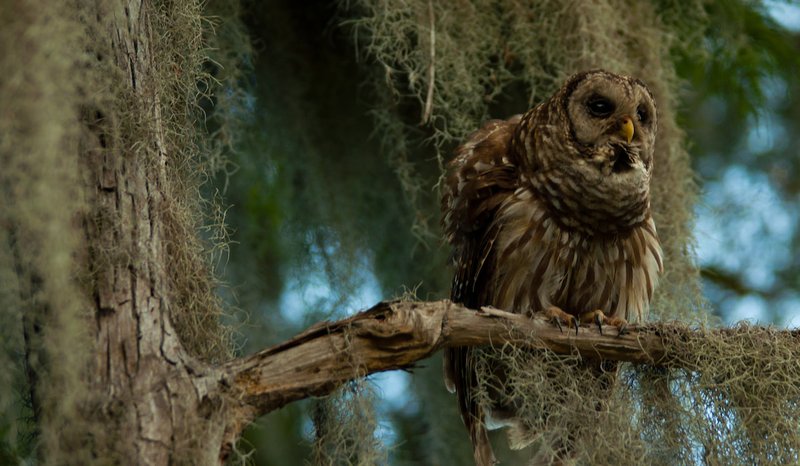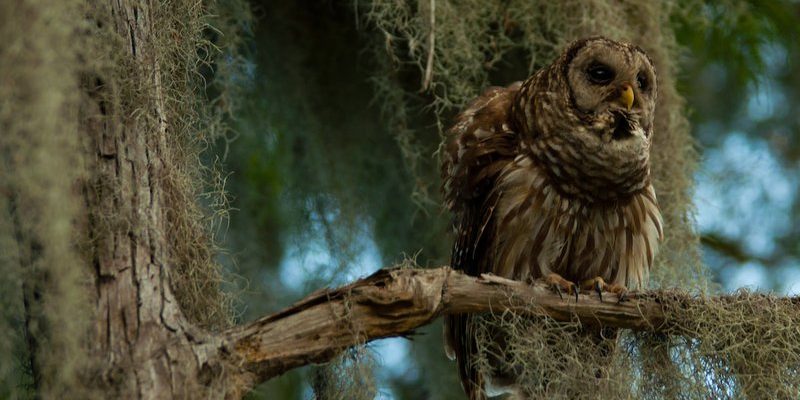
Imagine you’re in a forest, surrounded by the sounds of nature. You hear a soft “who cooks for you?” echoing through the trees; it’s the Barred Owl! But just nearby, you might spot a Great Horned Owl with its tufted ears and fierce presence. Understanding the differences between these owls not only enhances your birdwatching experience but can also deepen your appreciation for the variety found in nature. So, let’s explore how the Barred Owl stands apart from similar species.
Physical Characteristics of the Barred Owl
The Barred Owl (Strix varia) has some striking features that make it easily recognizable. Its body is a mix of brown and white, with bold dark stripes across its chest, resembling the stripes of a bar code—hence the name “Barred Owl.” It has a rounded head and lacks the ear tufts seen in some other owls. This gives it a softer, more rounded appearance, which can make it seem less intimidating than its more robust relatives.
Honestly, these physical traits aren’t just for show. The Barred Owl’s coloring helps it blend seamlessly into its wooded habitat, providing excellent camouflage from both predators and potential prey. This clever adaptation allows it to be an effective hunter, often preying on small mammals, birds, and even amphibians. Its large, dark eyes are also a defining characteristic, giving it exceptional vision during low-light conditions.
Coloration and Patterns
What about the coloration? The Barred Owl’s plumage varies from light to dark brown, with white spots that break up its outline. This natural patterning makes them difficult to spot among branches and foliage. This feature is essential for hunting, as they often rely on stealth. In contrast, the Great Horned Owl has more prominent “ear” tufts and a more robust definition of color, primarily gray-brown with a paler face.
You might be wondering how this affects their hunting styles. While both owls are nocturnal, the Barred Owl is known for being more active during twilight as well. This means you might catch a glimpse of it just as the sun sets, making it an exciting find for bird watchers.
Size and Shape Comparison
When it comes to size, the Barred Owl is medium-sized compared to other owl species. It typically measures about 16 to 25 inches in length, with a wingspan that can reach up to 50 inches! This size allows for impressive flight maneuvers as it glides silently through the trees.
On the other hand, the Great Horned Owl is noticeably larger, often weighing up to five and a half pounds and sporting that robust, stocky body. With its impressive wingspan, it almost gives a sense of majesty as it soars through the night sky. The Barn Owl, in contrast, is smaller and more slender, with a unique heart-shaped face that sets it apart from both the Barred and Great Horned Owls.
Adaptations and Behaviors
Adaptation plays a crucial role in how these owls interact with their environment. The Barred Owl is a versatile hunter, often found in various habitats, from dense forests to suburban areas. It has a hooting call that can carry for miles, making it easy to locate. Its vocalizations are quite different from the Great Horned Owl, which has a deep, resonant hoot that can sound quite intimidating.
Behaviorally, the Barred Owl is known for its curious nature. Unlike some other owls that may shy away from humans, they are often seen during the day or perched in plain sight. This openness allows for some excellent birdwatching opportunities. However, it also makes them more vulnerable.
Habitat Preferences
The Barred Owl enjoys a mix of woodlands and water bodies. You can find them near swamps, rivers, or lakes, where they hunt for food. They prefer old-growth forests and riparian areas, which provide ample cover and hunting opportunities.
Comparatively, the Great Horned Owl can thrive in a broader range of habitats, including open fields, deserts, and urban areas. It’s adaptable and can make its home almost anywhere. The Barn Owl, however, prefers open fields and farmland, where it can hunt for small mammals like mice and voles.
This difference in habitat can affect your chances of spotting these birds. If you’re hoping to see a Barred Owl, seek out dense woodlands or areas near water. If you’re in an open field, keep your eyes peeled for the Barn Owl, which might be gliding silently in search of dinner.
Diet and Hunting Techniques
Now, let’s discuss food. The Barred Owl has a diverse diet—it’s not picky! This owl primarily feeds on small mammals like squirrels and rabbits but will also eat birds, reptiles, and even insects. Its hunting style involves quietly perching and waiting for the right moment to swoop down on unsuspecting prey.
In contrast, the Great Horned Owl, often referred to as the “tiger owl,” preys on larger animals, including domestic pets. It’s a fierce predator and known for its ferocity. The Barn Owl, on the other hand, primarily hunts rodents and uses its exceptional hearing to detect prey in total darkness.
Here’s the thing: these dietary differences greatly influence their roles in the ecosystem. By controlling rodent populations, for instance, the Barn Owl plays an essential role in maintaining balance in its environment.
Calls and Communication
Communication is another area where these owls differ significantly. The Barred Owl’s call is iconic—its rhythmic “Who cooks for you?” is pretty unforgettable. It’s a call that many people recognize, and it serves to establish territory and attract mates.
Conversely, the Great Horned Owl’s call is a deep, booming hoot that can be heard several miles away. It has a more menacing tone, which matches its robust nature. The Barn Owl is much quieter, but its eerie screech can send shivers down your spine, especially if you hear it at night.
These vocalizations are not just for show. They help the owls communicate with each other, whether to warn of danger, attract a mate, or establish territory.
Conservation Status and Threats
Unfortunately, like many wildlife species, Barred Owls face threats from habitat destruction and climate change. Although they are not currently endangered, their populations can be negatively affected by logging and urban expansion. It’s essential to protect their habitats to ensure their survival.
The Great Horned Owl, while more adaptable, is also impacted by similar threats. It can thrive in developed areas, but diminishing natural habitats may still pose risks. On the flip side, the Barn Owl is classified as a species of concern in many regions due to its specific habitat needs.
By understanding and recognizing the differences between these species, we can appreciate their unique contributions to our ecosystems and the importance of conservation efforts.
In summary, the Barred Owl is a fascinating bird with unique characteristics and traits that set it apart from similar species. From its distinctive appearance and vocalizations to its adaptable nature, it truly holds its own in the avian world. Whether you’re a seasoned birdwatcher or someone just developing an interest, knowing the differences between the Barred Owl, Great Horned Owl, and Barn Owl can enhance your appreciation for these incredible creatures.
So, next time you’re out in nature, keep your eyes and ears open. You might just catch a glimpse or hear the call of the Barred Owl, reminding you of the wonders of the wildlife that share our world.

